University of Nebraska–Lincoln
The University of Nebraska–Lincoln (Nebraska, UNL, or NU) is a public research university in Lincoln, Nebraska. It is the state's oldest university and the largest in the University of Nebraska system.
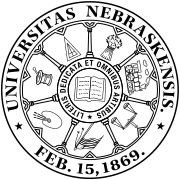 | |
| Latin: Universitas Nebraskensis | |
| Motto | Literis Dedicata et Omnibus Artibus (Latin) |
|---|---|
Motto in English | Dedicated to Letters and All the Arts |
| Type | Public Land grant Flagship |
| Established | February 15, 1869[1] |
Parent institution | University of Nebraska system |
Academic affiliations | URA APLU BTAA |
| Endowment | $1.435 billion (2019)[2] |
| Chancellor | Ronnie D. Green |
| President | Ted Carter |
Academic staff | 1,397 (Fall 2018)[3] |
| Students | 25,820 (Fall 2018)[4] |
| Undergraduates | 20,830 (Fall 2018)[4] |
| Postgraduates | 4,990 (Fall 2018)[4] |
| Location | , , United States 40°49′03″N 96°42′05″W |
| Campus | Urban, 613 acres (248 ha) 42,562 acres (17,224 ha) total throughout state |
| Colors | Scarlet and cream[5] |
| Nickname | Cornhuskers |
Sporting affiliations | NCAA Division I – Big Ten |
| Mascot | Herbie Husker Lil' Red |
| Website | www |
 | |
The state legislature chartered the university in 1869 as a land-grant university under the 1862 Morrill Act, two years after Nebraska became a state. At the turn of the 20th century, the university expanded significantly, hiring professors from eastern schools to teach its new professional programs and conducting groundbreaking research in agricultural sciences. The "Nebraska method" of ecological study developed during this time pioneered grassland ecology and laid the foundation for research in theoretical ecology for the rest of the century.[6][7]
The university is organized into eight colleges on two campuses in Lincoln with over 100 classroom buildings and research facilities.[8] It is classified among "R1: Doctoral Universities – Very high research activity".[9] According to the National Science Foundation, Nebraska spent $308 million on research and development in 2018, ranking it 78th in the nation.[10]
Nebraska's athletic programs, known as the Cornhuskers, compete in NCAA Division I and are a member of the Big Ten Conference. NU's football team has won 46 conference championships and claims five national championships, with an additional nine unclaimed. The school's volleyball team has won five titles and appeared in the national semifinal nine other times.[11] NU plays its home football games at Memorial Stadium and has sold out every game since 1962. The stadium's capacity of 91,585 people is famously larger than the population of Nebraska's third-largest city.[12][13]
History
The University of Nebraska was created by an act of the Nebraska state legislature in 1869, two years after Nebraska was admitted into the Union as the 37th state. The law described the new university's aims: "The object of such institution shall be to afford to the inhabitants of the state the means of acquiring a thorough knowledge of the various branches of literature, science, and the arts."[14] The school received an initial land grant of about 130,000 acres (53,000 ha) through the Morrill Act of 1862. Campus construction began in September 1869 with University Hall at 11th and S Streets, and two years later the University welcomed its inaugural class of 20 collegiate students along with 110 preparatory students.[15] By 1873, the University of Nebraska had offered its first two degrees to its inaugural graduating class.[16] The school's enrollment and budget remained relatively small until about 20 years after its founding, when its high school programs were taken over by a new state education system. From 1890 to 1895 enrollment rose from 384 to about 1,500. Shortly after, a law school and a graduate school were created, the latter making NU the first university west of the Mississippi River to establish a graduate school.[17] By 1897, the school had the 15th-highest total enrollment in the United States.[18]
Throughout the early 20th century, the university attempted to balance its identity as both a pragmatic, frontier establishment and an academic, intellectual institution.[19] Around this time, NU founded several noteworthy campus organizations, including a football team, a debate team, and its first fraternities and sororities.[20] In 1913, a fierce debate ensued over whether to keep the university in downtown Lincoln or to move it out of town. The issue was not resolved until a statewide referendum decided the school would remain at its current location. After purchasing property in the downtown area, the school funded several new buildings, both on the new property and its farming campus in east Lincoln. The school would not experience another expansion of this magnitude until the late 1940s, when the sudden arrival of thousands of soldiers seeking education after returning from World War II forced the school to seek further expansion.[21]
In 1908, Nebraska was inducted as a member of the Association of American Universities, an organization of research universities.[22] In recent years, Nebraska ranked near the bottom of the AAU's statistical criteria for members, a ranking attributed in part to the university's extensive agricultural research funded by the U.S. Department of Agriculture, which is not included in the AAU's rankings because it is not awarded by peer-reviewed grants; and because Nebraska's medical school is a separate institution whose research funding is not under UNL's auspices. Nebraska successfully retained its AAU membership after a 2000 challenge, which provided the school with an advantage when the Big Ten was looking to expand in 2010, as all of its members at that time were AAU members. Nebraska Chancellor Harvey Perlman stated "I doubt that our application would've been accepted had we not been a member of the [AAU]."[23] However, in 2011, after an extended campaign to retain its membership and a close, contentious vote, Nebraska became the only institution to be removed from the AAU membership by a vote of the membership (a few other institutions had voluntarily resigned.)[24][25][26][27]
In June 2018, the American Association of University Professors (AAUP) voted to censure the university for violations of academic freedom. In 2017, an adjunct instructor was filmed by a student as the instructor expressed a political opinion about the student's activist activities. State lawmakers demanded that the university hold the instructor accountable and the university subsequently fired her, a move the AAUP contends was a violation of her academic freedom.[28]
Administration and organization

Organizations
Board of Regents
The University of Nebraska system is governed by a board of regents, consisting of eight voting members, and a non-voting student body president from each campus. The board supervises the general operations and directs all expenditures of each university.
Faculties and schools
The university has nine colleges, combining to offer more than 150 undergraduate majors, 20 pre-professional programs, and 100 graduate programs.[29] NU also offers programs at its campus from other University of Nebraska institutions, including the University of Nebraska at Omaha (UNO) College of Public Affairs and Community Service, the University of Nebraska Medical Center (UNMC) colleges of Dentistry and Nursing, and the Peter Kiewit Institute, managed in partnership with UNO.[29]
- College of Agricultural Sciences and Natural Resources
- College of Architecture
- College of Arts and Sciences
- College of Business
- College of Education and Human Sciences
- College of Engineering
- Hixson–Lied College of Fine and Performing Arts
- College of Journalism and Mass Communications
- College of Law
Campuses
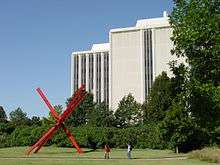
In 1869, the original University of Nebraska campus was laid out on four city blocks and comprised one building called University Hall. Currently, the university has three campuses, totaling 2,815 acres (1,139 ha): City Campus, north of downtown Lincoln; Nebraska Innovation Campus, just northeast of City Campus on the old Nebraska State Fair grounds; and East Campus, one mile east of City Campus.
Both City and East campuses include academic and research facilities, libraries, recreation centers, and residential buildings. They both feature various support buildings for power and networking, as well as in-ground infrastructure supporting advanced computing, power distribution, and energy-efficient heating and cooling from central plants. Both campuses are heavily landscaped, with the grounds functioning as a research mission of the university; they are administered as the UNL Botanical Garden and Arboretum,[30] which handles major plantings including Cather Garden on City Campus and Maxwell Arboretum on East Campus.
In January 2010, the university acquired a 249-acre (101 ha) property northeast of City Campus that had been used to host the Nebraska State Fair. Plans for redevelopment included an US$800 million expansion to house agricultural biotechnology and other life science research.[31][32] This project resulted in the construction of Nebraska Innovation Campus, a public/private research park located adjacent to the Bob Devaney Sports Center. Its buildings include several modernized structures formerly used for the state fair.[33]
The Adele Coryell Hall Learning Commons, named in honor of alumna Adele Coryell Hall, were opened in 2016. The $10 million, 30,000 square-foot project was largely funded with $7 million in private donations. The learning commons are located on the first floor of Love Library North and feature private study rooms with wall-to-wall whiteboards and smart TVs.[34][35][36]
Unions
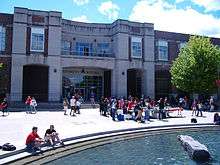
UNL has student union facilities on both City and East campuses. The Nebraska Union is the located on the southern part of City Campus, northeast of 14th and R Streets. The Nebraska East Union is located east of East Campus Mall. The services the unions offer to students include dining, banking, computer labs, and recreational activities. University Bookstore locations are available at each facility. The Nebraska Union provides meeting space for events and speakers, and includes offices for The Daily Nebraskan, student government, and Greek Affairs. The East Union houses the Loft Gallery, a space for community and student artwork, and a full-service bowling alley, the home facility for Nebraska's bowling team.
Points of interest
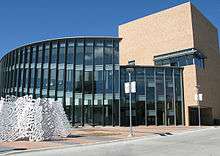
- The Lied Center for Performing Arts is a performing arts venue used primarily for orchestra concerts and theatre performances. The Mary Riepma Ross Media Arts Center is a two-screen theater on City Campus featuring arthouse and independent films, and documentaries. The Howell Theatre, Studio Theatre, and Lab Theatre are home to the Johnny Carson School of Theatre and Film.
- Architecture Hall, formerly the university's library and now home of its architecture program, is the oldest building on campus. The historic structure is linked to the old law building via a glass structure known as "The Link." The Kruger Collection of miniature furniture and decorative arts is on display.[37]
- Since 1928, NU has been the headquarters of the National Society of Pershing Rifles, a military fraternal organization for college-level students. John J. Pershing, an 1893 NU law school graduate and professor of Military Science and Tactics, created "Company A," a competitive drill team, for the University of Nebraska's Cadet Corps in 1891. The drill team won the National Competitive Drills in 1892, and eventually changed its name to the "Pershing Rifles" in 1895 in honor of Pershing.
- The Mueller Tower, named for alumnus Ralph S. Mueller, is an 84-foot (26 m) carillon built in 1949.[38]
- The International Quilt Study Center on East Campus was founded in 1997 and houses the largest public quilt collection in the world.[39]
- The Maxwell Arboretum on East Campus is part of the Nebraska Statewide Arboretum.
Sustainability
The University of Nebraska has adopted LEED certification for all new construction projects. UNL's Sustainable Food Project, started in 2005, is designed to serve meals on campus that feature locally and sustainably produced foods. The university's motor pool includes vehicles fueled by soy biodiesel as well as gasohol (85 percent ethanol, 15 percent gasoline blend). The university received a grade of C on the College Sustainability Report Card 2011.[40] The school has since established an Office of Sustainability in 2014 with projects such as EarthStock and Bugeater Student Organic Farm.
Academics
| University rankings | |
|---|---|
| National | |
| ARWU[41] | 67–94 |
| Forbes[42] | 239 |
| THE/WSJ[43] | 401–500 |
| U.S. News & World Report[44] | 139 |
| Washington Monthly[45] | 140 |
| Global | |
| ARWU[46] | 201–300 |
| QS[47] | 561–570 |
| THE[48] | 351–400 |
| U.S. News & World Report[49] | 290 |
Admissions and demographics
Admission to the University of Nebraska–Lincoln is rated "more selective" by U.S. News & World Report. US News also ranks Nebraska as the #139 national university in the country.[50] For the 2015 fall semester, NU received 9,724 freshmen applications; 7,425 were admitted (76.4 percent) and 4,628 enrolled. The high school grade point average (GPA) of enrolled freshmen was 3.65, while the middle 50 percent range of SAT scores was 500–630 for critical reading and 500–660 for math. The middle 50 percent range of the ACT Composite score was 22–28. Twenty-six percent of enrolled freshmen were in the top tenth of their high school class and 52 percent were in the top quarter.[51]
As of 2018, 74 percent of UNL's undergraduates were classified as "white, non-Hispanic"; 53 percent of the undergraduate population was male and 47 percent female.[4]
University libraries

The university's libraries, which combine to offer 3.5 million volumes, are the only set of comprehensive research libraries in Nebraska. The Don L. Love Memorial Library is the main library on City Campus and houses collections on social sciences and humanities.[52] Other academic disciplines are housed in seven branch locations on campus:
- Architecture Library
- C.Y. Thompson Library (Colleges of Agricultural Sciences and Natural Resources, Dentistry, and Special Education & Communication Disorders)
- Engineering Library
- Geology Library
- Marvin and Virginia Schmid Law Library (College of Law)
- Mathematics Library
- Music Library
Museums and galleries
The University of Nebraska State Museum is located in Morrill Hall on City Campus. The museum houses collections and exhibits featuring natural history, including its most popular attraction, a set of Mammoth fossils. Because of these fossils and a bronze Columbian Mammoth statue in front of the building, it is popularly known as "Elephant Hall."
The Sheldon Memorial Art Gallery and Sculpture Garden is home to more than 12,000 works of art in all media and is a comprehensive collection of American visual art. It has prominent holdings in 19th century landscape and still life, American impressionism, early modernism, geometric abstraction, abstract expressionism, pop, minimalism, and contemporary art. The museum has the largest collection of 20th Century North American art in the world; it includes works by artists including Edward Hopper, Andy Warhol, Jackson Pollock, Mary Cassatt, Wayne Thiebaud, and Georgia O'Keeffe.
The Great Plains Art Museum is home to the Christlieb Collection, and features American western art and Americana.[53]
The Lester F. Larsen Tractor Museum is on East Campus. It houses 40 historical tractors, an antique auto, and various farm tools. Additionally, it documents Nebraska's tractor testing law examination that tests all tractors sold in Nebraska to ensure performance is as advertised.
The Robert Hillestad Textiles Gallery is located on the second floor of the Home Economics building on East Campus. It features exhibitions of textiles and clothing, both historic and contemporary.[54]
The Kruger Collection is a display of miniature furniture and decorative arts located in Architecture Hall.[55]
Other university art galleries include the Eisentrager-Howard Gallery and the student-run MEDICI Gallery in Richards Hall.[56] The Lentz Center for Asian Culture is no longer open to the public. Its collection of Asian ceramics, paintings, prints, sculpture, and textiles has been digitized for online viewing.
Digital Research
The Center for Digital Research in the Humanities carries out numerous digital humanities projects funded by institutions including the National Endowment for the Humanities. It works with multiple departments across campus including Modern Languages, Anthropology, Art & Art History, and History. The center has worked on several digital history projects,[57] including Civil War Washington,[58][59] Railroads and the Making of Modern America,[60] and O Say Can You See: Early Washington D.C., Law & Family.[61]
The university's English Department has an active program in the digital humanities, with digital projects such as the Walt Whitman Archive,[62] the Willa Cather Archive,[63] and the international collaboration Livingstone Online. Projects are also underway for the production of a free online Native American Omaha-Ponca language dictionary.[64] In addition, the Center for Digital Research in the Humanities hosted the annual conference of the Alliance of Digital Humanities Organizations in 2014.
Athletics
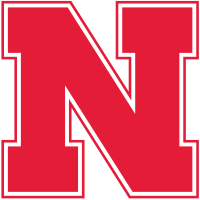
The Nebraska Cornhuskers (often abbreviated to Huskers) are the intercollegiate athletic teams that represent the University of Nebraska–Lincoln. The university is a member of the Big Ten Conference and the Cornhuskers compete in NCAA Division I, fielding 22 varsity teams (9 men's, 13 women's) in 15 sports. Nineteen of these teams participate in the Big Ten, while rifle is a member of the single-sport Great America Rifle Conference and beach volleyball and bowling compete as independents.
Early nicknames for the university's athletic teams included the Old Gold Knights and the Bugeaters. Cornhuskers first appeared in a school newspaper headline ("We Have Met The Cornhuskers And They Are Ours"), after a 20–18 upset victory over Iowa in 1893. In this instance, Cornhuskers was used to refer to Iowa.[65][66][67] The first time the name was applied to Nebraska was in 1899, when Nebraska State Journal writer Cy Sherman, who would later help originate the AP Poll, began referring to Nebraska's football team as the Cornhuskers. The next year, the nickname was officially adopted by the school.[68][69][70]
For nearly 100 years, the Cornhuskers participated in the Big Eight Conference (previously known as the Missouri Valley Intercollegiate Athletic Association, the Big Six, and the Big Seven), and later for 15 years in the Big 12 Conference, which was formed when the Big Eight merged with four members of the defunct Southwest Conference. Nebraska joined the Big Ten in 2011.
The Cornhuskers have two official mascots, Herbie Husker and Lil' Red.
Football
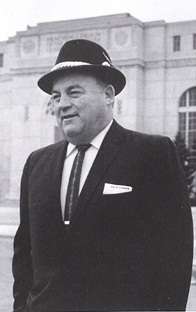
NU's football team competes as part of the NCAA Division I Football Bowl Subdivision, in the West Division of the Big Ten. Nebraska plays its home games at Memorial Stadium, where it has sold out every game since 1962.[71] The team is currently coached by Scott Frost.
Nebraska is among the most storied programs in college football history. The Cornhuskers trail only three other programs in all-time victories among FBS teams, and have won more games against Power Five opponents than any other program.[72] Nebraska claims 46 conference championships and five national championships (1970, 1971, 1994, 1995, and 1997), and has won nine other national championships that the school does not claim.[73][74]
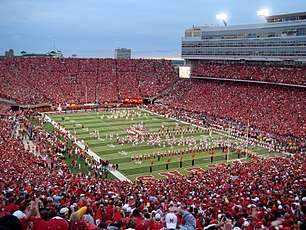
NU's 1971 and 1995 title-winning teams are considered by many to be among the best in college football history.[75] Famous Cornhuskers include Heisman Trophy winners Johnny Rodgers, Mike Rozier, and Eric Crouch. Rodgers and Rozier join 22 other Cornhuskers in the College Football Hall of Fame.
The program's first extended period of success came just after the turn of the century. Between 1900 and 1916, Nebraska had five undefeated seasons and completed a stretch of 34 consecutive games without a loss, still a program record.[76] Despite a span of 21 conference championships in 33 seasons, the Cornhuskers didn't experience major national success until Bob Devaney was hired in 1962. In eleven seasons as head coach, Devaney won two national championships, eight conference titles, and coached 22 All-Americans, but perhaps his most lasting achievement was the hiring of Tom Osborne as offensive coordinator in 1969.[77] Osborne was named Devaney's successor in 1973, and over the next 25 years established himself as one of the best coaches in college football history with his trademark I-form offense and revolutionary strength, conditioning, and nutrition programs.[78] Following Osborne's retirement in 1997, Nebraska cycled through four head coaches before hiring state native Scott Frost in 2017.[79]
Fight songs
The University of Nebraska's fight song is Hail Varsity. Dear Old Nebraska U (There is No Place Like Nebraska), while not the school's official fight song, is often heard more frequently at sporting events and university functions than Hail Varsity. The lyrics and music to Dear Old Nebraska U are attributed to Harry Pecha, a 1924 NU graduate.[80] Other schools and locales across the United States – including the University of Chicago, the University of Florida, and the Toledo public school system – sing similar tunes, often with similar lyrics.[81]
Student life
About 78 percent of NU's students are from Nebraska, but the remaining 22 percent is made up of students from all forty-nine other states and 114 foreign countries. On-campus students are members of the UNL Residence Hall Association, which serves as the governing body for residence halls. Select honorary seniors include the Nebraska-only Society of Innocents and the Black Masque chapter of Mortar Board.
Residence halls
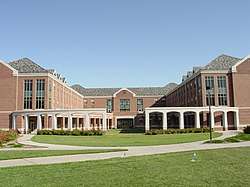
Approximately 40 percent of the student body lives on-campus in 15 traditional residence halls, two on-campus apartment-style halls, and three on-campus suite-style halls.
There are nine traditional residence halls on City Campus:
- Abel
- Harper
- Husker Hall
- Kauffman Center
- Neihardt
- Sandoz
- Schramm
- Selleck
- Smith
City Campus also features two on-campus apartment-style halls (The Courtyards and The Village) and three on-campus suite-style halls (Eastside Suites, Knoll Residential Center, and University Suites). Cather and Pound were traditional residence halls on City Campus demolished in 2017. There is one residential hall and one residential center on East Campus: Massengale Residential Center, which contains both traditional and apartment-style housing, and Love Memorial Co-op.
Student organizations
NU's governing body for students is the Association of Students of the University of Nebraska (ASUN). Every year students vote for a president, two vice presidents, and a senate composed of representatives from each college. The president acts as the student regent to the NU Board of Regents.
NU has over 400 student organizations on campus that represent a variety of interests.[82] Organizations are supported by Student Involvement.
Greek organizations
UNL has a significant Greek population, with about 5,200 students in 30 fraternities (28 chapters and two colonies) and 16 sororities.
| Sororities | Fraternities | |
|---|---|---|
Media
The Daily Nebraskan, known to students as the "DN", is NU's student newspaper. It was established in 1901 and was published every weekday during the fall and spring semesters and weekly during the summer until 2017, when students voted to reduce the paper's funding. The DN now operates mainly online, publishing only a monthly print copy.[83] In February 2008, The Publications Board recognized The DailyER as an affiliated publication and approved the printing costs of the first three issues of the satirical paper.[84]
UNL operates a Class A FM radio station, KRNU, which broadcasts on 90.3 FM and has a range of approximately 20 miles (32 km). The station plays mostly alternative and modern rock, as well as broadcasts of news, campus speakers and forums, and some home sporting events.
Notable alumni, faculty, and staff
Many UNL alumni have had considerable success in athletics, scientific research, public service, education, and business. Notable alumni include:
- Warren Buffett (Entrepreneur, investor, philanthropist)
- Jordan Burroughs (Olympic gold medalist wrestler)
- Johnny Carson (Television personality)
- Willa Cather (Author)
- Scott Frost (Nebraska head coach)
- Roxane Gay (writer and professor)
- Alex Gordon (MLB player)
- Ted Kooser (U.S. poet laureate)
- Tommy Lee (Drummer)
- Tyronn Lue (Former NBA coach and player)
- Gene Okerlund (Wrestling interviewer, announcer, host)
- Tom Osborne (Hall of Fame coach, U.S. congressman)
- John J. Pershing (Military)
- Khanto Bala Rai, Indian educator, school head
- Joel Sartore (Photographer)
- Will Shields (NFL Hall of Famer)
- Ted Sorensen (Politics)
- Ndamukong Suh (NFL player)
- Zac Taylor (Cincinnati Bengals head coach)
- Kārlis Augusts Vilhelms Ulmanis (founding father of the Republic of Latvia and first Prime minister[85])
- Tony Watson, (Major League Baseball player for the San Francisco Giants)
- Evan Williams (Twitter co-founder)
- Jeff Zeleny (CNN correspondent)
Three alumni have won the Nobel Prize, eight have won the Pulitzer Prize, 22 have been selected as Rhodes Scholars, one has been selected as a Marshall Scholar, 29 have been selected as Goldwater Scholars and 15 have been selected as Truman Scholars. In 2010 NU was named a Truman Scholarship Honor Institution.[86]
References
- "University of Nebraska Administration - History & Mission". Nebraska.edu. Archived from the original on December 24, 2015. Retrieved December 23, 2015.
- As of June 30, 2019. "U.S. and Canadian 2019 NTSE Participating Institutions Listed by Fiscal Year 2019 Endowment Market Value, and Percentage Change in Market Value from FY18 to FY19 (Revised)". National Association of College and University Business Officers and TIAA. Retrieved April 20, 2020.
- "Common Data Set 2018-2019, Part I" (PDF). University of Nebraska–Lincoln. Archived (PDF) from the original on March 6, 2019. Retrieved March 4, 2019.
- "Common Data Set 2018-2019, Part B" (PDF). University of Nebraska–Lincoln. Archived (PDF) from the original on March 6, 2019. Retrieved March 4, 2019.
- "Official University Colors". UComm.UNL.edu. University of Nebraska–Lincoln Communications & Strategic Marketing. Retrieved May 24, 2020.
- Vandervoort, Frances (1999). "A Green Centennial". The American Biology Teacher. University of California. 61 (9): 648–659. doi:10.2307/4450796. JSTOR 4450796.
- Merchant, Carolyn (2005). "Chapter 9: The Rise of Ecology 1890–1990". The Columbia Guide to American Environmental History. Manhattan, NY: Columbia University Press. pp. 163–164. ISBN 978-0-231-11233-8. Retrieved September 9, 2010.
- "UNL Historic Buildings – Historical Overview". Lincoln, NE: University of Nebraska–Lincoln. 2005. Archived from the original on June 7, 2010. Retrieved September 5, 2010.
- "Carnegie Classifications Institution Lookup". carnegieclassifications.iu.edu. Center for Postsecondary Education. Retrieved July 26, 2020.
- "Table 20. Higher education R&D expenditures, ranked by FY 2018 R&D expenditures: FYs 2009–18". ncsesdata.nsf.gov. National Science Foundation. Retrieved July 26, 2020.
- "Nebraska volleyball history". NU Athletics. Archived from the original on October 8, 2008. Retrieved September 5, 2010.
- "Husker Football History" (PDF). Huskers.com. Archived (PDF) from the original on March 3, 2016. Retrieved September 5, 2010.
- "Memorial Stadium – Home of the Huskers". Huskers.com. 2010. Archived from the original on October 15, 2010. Retrieved September 5, 2010.
- Pound, Louise. Semi-centennial Anniversary Book. Lincoln: University of Nebraska Press. 1919. p. 14.
- "Nebraska Historical Marker: The University of Nebraska". Nebraska State Historical Society. Archived from the original on October 24, 2019. Retrieved October 12, 2019.
- Pound, Louise. Semi-centennial Anniversary Book. Lincoln: University of Nebraska Press. 1919. pp. 11–19.
- The first school west of the Mississippi River to issue a graduate degree was Washington University in St. Louis. UNL was the first school in the region to formally organize a school for graduates. Archived August 19, 2010, at the Wayback Machine "Archived copy" (PDF). Archived from the original (PDF) on May 28, 2010. Retrieved September 6, 2010.CS1 maint: archived copy as title (link) "Archived copy". Archived from the original on March 18, 2012. Retrieved September 6, 2010.CS1 maint: archived copy as title (link) "Archived copy". Archived from the original on July 16, 2011. Retrieved September 6, 2010.CS1 maint: archived copy as title (link) "Archived copy". Archived from the original on June 9, 2010. Retrieved September 6, 2010.CS1 maint: archived copy as title (link)"Archived copy". Archived from the original on August 19, 2010. Retrieved September 6, 2010.CS1 maint: archived copy as title (link)
- Luebke, Frederick. Nebraska: an Illustrated History. Lincoln: University of Nebraska Press, 2005. pp.172–3 ISBN 0-8032-8042-4
- Knoll, Robert. Prairie University. Lincoln: University of Nebraska Press, 1995. pp. 38–39. ISBN 0-8032-2717-5
- Knoll, Robert. Prairie University. Lincoln: University of Nebraska Press, 1995. pp. 43–44 ISBN 0-8032-2717-5
- "UNL Historic Buildings - Historical Overview". Historicbuildings.unl.edu. Archived from the original on July 8, 2008. Retrieved May 20, 2012.
- Knoll, Robert E. (August 1, 1995). "The Pattern of the Modern University". Prairie University: a History of the University of Nebraska. Lincoln: University of Nebraska Press. pp. 47–54. ISBN 978-0-8032-2717-0. Archived from the original on June 10, 2016. Retrieved September 6, 2010. Excerpt available Archived October 19, 2018, at the Wayback Machine at Google Books.
- Hine, Chris (June 13, 2010). "Nebraska has it all to attract Big Ten, most importantly AAU membership". Chicago Tribune. Archived from the original on September 6, 2011. Retrieved July 17, 2011.
- Abourezk, Kevin (April 29, 2011). "Research universities group ends UNL's membership". Lincoln Journal Star. Archived from the original on May 3, 2011. Retrieved May 4, 2011.
- Reed, Leslie (April 30, 2011). "Academic group drops UNL". Omaha World-Herald. Archived from the original on January 27, 2012. Retrieved May 4, 2011.
- Lewin, Tamar (May 2, 2011). "American Universities Group Votes to Expel Nebraska". The New York Times. Archived from the original on May 6, 2011. Retrieved May 4, 2011.
- Selingo, Jeffrey J.; Jack Stripling (May 2, 2011). "Nebraska's Ouster Opens a Painful Debate Within the AAU". The Chronicle of Higher Education. Archived from the original on August 28, 2011. Retrieved May 4, 2011.
- Flaherty, Colleen (June 18, 2018). "AAUP Censure for Nebraska". Inside Higher Ed. Archived from the original on June 18, 2018. Retrieved June 18, 2018.
- "UNL | Colleges and Departments A-C". Unl.edu. July 23, 2009. Archived from the original on May 26, 2009. Retrieved May 20, 2012.
- "Botanical Garden and Arboretum". University of Nebraska. Archived from the original on June 15, 2017. Retrieved June 26, 2017.
- "University of Nebraska Board of Regents approve Innovation Campus". JournalStar.com. Archived from the original on December 25, 2009. Retrieved August 2, 2011.
- "Nebraska Innovation Campus". University of Nebraska–Lincoln. Archived from the original on July 20, 2011. Retrieved August 2, 2011.
- "University of Nebraska Innovation Campus". University of Nebraska-Lincoln. Archived from the original on July 3, 2017. Retrieved June 26, 2017.
- "UNL celebrates opening of Adele Hall Learning Commons". Archived from the original on November 18, 2016.
- Fedderson, Troy (January 5, 2016). "Learning Commons to include Dunkin' Donuts location". University of Nebraska- Lincoln. Archived from the original on November 18, 2016.
- Bowling, Chris (January 12, 2016). "UNL unveils $10 million renovation to library learning commons, 'a different kind of space'". Omaha World Herald. Archived from the original on October 24, 2019.
- "Kruger Collection". University of Nebraska-Lincoln. Archived from the original on September 21, 2017. Retrieved September 20, 2017.
- "Tradition-Inspiring Symbol Becomes New Landmark on N. U. Campus". The Lincoln Star. October 30, 1949. p. 35. Archived from the original on October 24, 2019. Retrieved May 22, 2019 – via Newspapers.com.
- "Outdoor sculpture 'Reverie' to be dedicated at quilt museum", University of Nebraska–Lincoln, May 6, 2008, archived from the original on August 19, 2019, retrieved August 19, 2019.
- "University of Nebraska–Lincoln Report Card 2011". Sustainable Endowments Institute. 2010. Archived from the original on December 15, 2010. Retrieved November 2, 2010.
- "Academic Ranking of World Universities 2020: National/Regional Rank". Shanghai Ranking Consultancy. Retrieved August 15, 2020.
- "America's Top Colleges 2019". Forbes. Retrieved August 15, 2019.
- "U.S. College Rankings 2020". Wall Street Journal/Times Higher Education. Retrieved September 26, 2019.
- "Best Colleges 2020: National University Rankings". U.S. News & World Report. Retrieved September 8, 2019.
- "2019 National University Rankings". Washington Monthly. Retrieved August 20, 2019.
- "Academic Ranking of World Universities 2020". Shanghai Ranking Consultancy. 2020. Retrieved August 15, 2020.
- "QS World University Rankings® 2021". Quacquarelli Symonds Limited. 2020. Retrieved June 10, 2020.
- "World University Rankings 2020". THE Education Ltd. Retrieved September 14, 2019.
- "Best Global Universities Rankings: 2020". U.S. News & World Report LP. Retrieved October 22, 2019.
- "U.S. News Best Colleges Rankings: University of Nebraska–Lincoln". U.S. News & World Report. 2019. Archived from the original on March 4, 2016. Retrieved September 9, 2019.
- "Common Data Set 2015-2016, Part C" (PDF). University of Nebraska–Lincoln. Archived (PDF) from the original on March 8, 2016. Retrieved March 2, 2016.
- "About UNL Libraries". University of Nebraska-Lincoln Libraries. Archived from the original on September 19, 2008. Retrieved September 22, 2008.
- "Great Plains Art Museum". Center for Great Plains Studies official website. Archived from the original on January 30, 2009. Retrieved January 11, 2009.
The Great Plains Art Museum opened in 1981 after a generous donation from Dr. John and Elizabeth Christlieb of Bellevue, Nebraska. The Christlieb Collection… consists of approximately 170 bronze sculptures, 140 paintings and drawings, 100 other works on paper and several hundred photographs, and includes artwork by Albert Bierstadt, William de la Montagne Cary, Robert Fletcher Gilder, William Henry Jackson, Frederic Remington, Charles M. Russell and Olaf Wieghorst. The library donated by the Christliebs is an impressive 4,000 volumes, which consists of several Western novels and many other fiction and nonfiction books about the West and the Great Plains.
- "Robert Hillestad Textiles Gallery". UNL. Archived from the original on June 26, 2013. Retrieved September 20, 2017.
- "Kruger Collection". UNL. Archived from the original on September 21, 2017. Retrieved September 20, 2017.
- "Eisentrager-Howard Gallery". UNL. Archived from the original on September 21, 2017. Retrieved September 20, 2017.
- " $300,000 grant will help UNL researcher digitize archaeological records" Archived January 23, 2016, at the Wayback Machine. March 23, 2015 By Chris Dunker | Lincoln Journal Star
- "150 Years Ago: Compensated Emancipation". National Endowment for the Humanities (NEH). Archived from the original on July 1, 2019. Retrieved May 16, 2019.
- "Civil War Washington". civilwardc.org. Archived from the original on January 20, 2016. Retrieved January 22, 2016.
- "Railroads and the Making of Modern America". railroads.unl.edu. Archived from the original on October 26, 2016. Retrieved November 15, 2016.
- "O Say Can You See: Early Washington, D.C., Law & Family". earlywashingtondc.org. Archived from the original on November 3, 2016. Retrieved November 15, 2016.
- "The Walt Whitman Archive". www.whitmanarchive.org. Archived from the original on November 14, 2016. Retrieved November 15, 2016.
- "Willa Cather Archive". cather.unl.edu. Archived from the original on May 18, 2011. Retrieved November 15, 2016.
- "Archived copy". Archived from the original on July 27, 2011. Retrieved November 21, 2009.CS1 maint: archived copy as title (link) CS1 maint: BOT: original-url status unknown (link)
- Fricke, Mark (2005). Nebraska Cornhusker Football. Arcadia Publishing. p. 17. ISBN 9780738534374.
- McHugh, Jolene (November 19, 2011). "From the archives: The Cornhuskers". omaha.com. Archived from the original on October 26, 2016. Retrieved October 26, 2016.CS1 maint: BOT: original-url status unknown (link)
- Fricke, Mark. "Nebraska Football In The 1890s" (PDF). library.la84.org. p. 11. Archived from the original on October 26, 2016. Retrieved October 26, 2016.CS1 maint: BOT: original-url status unknown (link)
- "Origin of the Cornhusker Nickname". Huskers.com. July 24, 2017. Archived from the original on March 27, 2019. Retrieved July 23, 2019.
- "Husker Press Box – The Beginning Of The Huskers". May 11, 2008. Archived from the original on May 11, 2008. Retrieved October 8, 2017.CS1 maint: BOT: original-url status unknown (link)
- Christopherson, Brian (June 20, 2009). "Deep Red: The story behind the name 'Cornhuskers'". journalstar.com. Archived from the original on October 26, 2016. Retrieved October 26, 2016.CS1 maint: BOT: original-url status unknown (link)
- "Nebraska vs. Missouri 1962". HuskerMax. Archived from the original on September 5, 2017. Retrieved August 19, 2019.
- "Archived copy" (PDF). Archived (PDF) from the original on May 21, 2016. Retrieved August 19, 2019.CS1 maint: archived copy as title (link)
- "Nebraska Conference Championships". Archived from the original on May 4, 2016. Retrieved October 23, 2016.
- "Title teams -- HuskerMax™". Archived from the original on November 6, 2016. Retrieved October 23, 2016.
- "Best college football teams of all-time". Archived from the original on July 14, 2016. Retrieved October 6, 2018.
- "Nebraska Football Schedules 1910–1919". HuskerMax. Archived from the original on June 3, 2012. Retrieved September 2, 2010.
- "Tom's Time: Devaney Selects His Successor". HuskerMax. Archived from the original on May 25, 2019. Retrieved May 24, 2019.
- "Epley leaving Huskers". Archived from the original on May 25, 2019. Retrieved May 24, 2019.
- "Nebraska officially announces hiring of Scott Frost, introductory press conference scheduled for Sunday". Archived from the original on May 25, 2019. Retrieved May 24, 2019.
- "UNL Band fight songs". University of Nebraska–Lincoln. Archived from the original on November 2, 2007. Retrieved December 2, 2007.
- "F-L-O-R-I-D-A, or is it T-O-L-E-D-O? – The Gainesville Sun". Gainesville.com. October 9, 2005. Archived from the original on August 4, 2016. Retrieved May 20, 2012.
- "UNL | Student Involvement | Student Organizations | Resources and Tools". Archived from the original on December 5, 2010. Retrieved December 10, 2010.
- Editor-in-Chief, Lani Hanson. "Letter from the editor: Smell ya later, DN". The Daily Nebraskan. Archived from the original on June 6, 2017. Retrieved July 25, 2017.CS1 maint: extra text: authors list (link)
- Dailyer Nebraskan receives approval – News Archived May 21, 2008, at the Wayback Machine
- "Ex Prime Ministers of the Republic of Latvia". Government of Latvia. July 19, 2011. Archived from the original on July 16, 2011. Retrieved July 19, 2011.
- "UNL named honor institution for supporting Truman Scholar". University of Nebraska–Lincoln. July 7, 2010. Archived from the original on February 22, 2014. Retrieved October 14, 2012.
External links
| Wikimedia Commons has media related to University of Nebraska–Lincoln. |
- Official website

- Nebraska Athletics website

- . New International Encyclopedia. 1905.